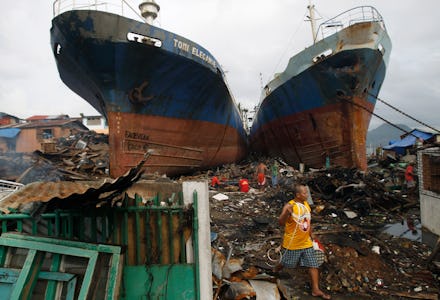6 Natural Disasters of 2013 That Left Us More Unprepared Than Ever

According to the journal Climatic Change, 140 organizations funnelled $558 million to climate denial organizations between 2003 and 2010. Of those 140 organizations include market giants like ExxonMobil and Koch Industries.
Yet, the evidence of climate change is undeniable. It confronts us every time we see words like "super typhoon" and "tsunami" in the news, words that were rarely used before the last decade. Climate change haunts us everytime we find closed metro stations and collapased buildings due to a super storm in one the world's most populated cities. More than half of all global species are potentially at risk of extinction, global food supplies are threatened by extreme weather events, and water is predicted to be the scarce resource that will incite future wars.
1. Typhoon Haiyan in Phillipines
On Nov. 8, Typhoon Haiyan tore through the Phillippines, claiming more than 6,000 lives and injuring a further 27,000. Nearly 4 million Filipinos were rendered homeless from the storm's impact.
Haiyan is widely recognized as one of the worst storms to hit the planet in recent history. While relief agencies struggle to understand its full damage, typhoon survivors have maintained their hope and vigor, including the mayor of Guiuan, a municipality in the Phillipines, who saved countless lives by evacuating his entire community hours after the storm.
2. Consecutive, 'Island-Creating' Earthquakes in Pakistan
On Tuesday, Sept. 24, 2013, a 7.7 magnitude earthquake struck southwest Pakistan, followed by another 6.8 shake on Saturday. The earthquakes claimed more than 800 lives. Recuperation continues in this seismically active region of the Indian subcontinent.
While the earthquakes have not been directly attributed to climate change, the creation of a brand new "island" off the coast of Pakistani province following the quakes has baffled the scientific community.
3. Tornadoes in Oklahoma
On May 20, a giant tornado with 200 mph winds took a 12-mile path through the Oklahoma City area, uprooting homes and impacting two elementary schools. Twenty four people were killed, and more than 100 others were injured. The week prior, as many as 10 tornadoes hit North Texas, killing six.
Crosses now stand in memory of the children killed in the disaster and rebuilding efforts continue in Oklahoma City.
4. Cyclone Phailin in India
Nearly 1 million people were evacuated before destructive Cyclone Phailin hit India in October 2013.
The cyclone, packing winds of 155 mph with gusts of up to 190 mph, hit the Bay of Bengal. The evacuation came as an attempt to avoid mass casualities similar to a 1999 cyclone in the same area. Whereas Cyclone Odisha claimed 10,000 lives in 1999, Phailin's destructions took 27.
Despite evacuation and relief efforts, the aftermath of the Cyclone had thousands marooned by rising flood waters caused by incessant rain in the aftermath of the Cyclone.state, Orissa.
5. Droughts in Africa, Courtesy Of the U.S. and Europe
In June 2013, a new study revealed that African droughts between the 1970s and 1990s was caused by pollution from the U.S. and Europe. This drought, the biggest to ever hit the planet, caused severe famines and killed hundreds of thousands of people during this period.
There were no comments on the terrible situation from major political leaders in the West, despite the fact that parts of Southern Africa including Namibia and South Africa continue to suffer from an on-going drought. One million people out of Namibia's 2.3 million population are threatened by moderate to serious malnutrition.
The Namibian government has estimated the harvest for 2013 will yield 42% less than that of 2012, and the numbers continue to decline.
6. Simultaneous Hurricane Duo in Mexico
In Mexico, Hurricane Ingrid, a Category 1 storm, converged with Hurricane Manuel, also a Category 1 storm, within hours to claim more than 169 lives in Mexico. Damage was estimated to cost more than $4.2 billion.
Tens of thousands of people were trapped in the aftermath of the dual storms, with over a million inhabitants affected in some way. Ensuing floods destroyed thousands of homes and shut down an airport, stranding tourists. Frantic looting and corruption followed the storms, adding to the misery of the aftermath and turning famous tourist spots such as Acapulco into a hideout for violent drug gangs.